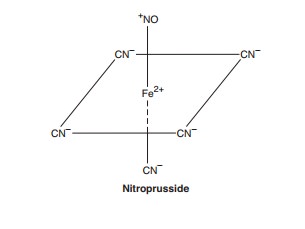Chapter: Basic & Clinical Pharmacology : Antihypertensive Agents
Sodium Nitroprusside
SODIUM NITROPRUSSIDE
Sodium
nitroprusside is a powerful parenterally administered vasodilator that is used
in treating hypertensive emergencies as well as severe heart failure.
Nitroprusside dilates both arterial and venous vessels, resulting in reduced
peripheral vascular resistance and venous return. The action occurs as a result
of activation of guanylyl cyclase, either via release of nitric oxide or by
direct stimulation of the enzyme. The result is increased intracellular cGMP,
which relaxes vascular smooth muscle (Figure 12–2).In the absence of heart
failure, blood pressure decreases, owing to decreased vascular resistance,
whereas cardiac output does not change or decreases slightly. In patients with
heart failure and low cardiac output, output often increases owing to afterload
reduction.

Pharmacokinetics & Dosage
Nitroprusside
is a complex of iron, cyanide groups, and a nitroso moiety. It is rapidly
metabolized by uptake into red blood cells with liberation of cyanide. Cyanide
in turn is metabolized by the mitochondrial enzyme rhodanase, in the presence
of a sulfur donor, to the less toxic thiocyanate. Thiocyanate is distributed in
extracellular fluid and slowly eliminated by the kidney.
Nitroprusside
rapidly lowers blood pressure, and its effects disappear within 1–10 minutes
after discontinuation. The drug is given by intravenous infusion. Sodium
nitroprusside in aque-ous solution is sensitive to light and must therefore be
made up fresh before each administration and covered with opaque foil. Infusion
solutions should be changed after several hours. Dosage typically begins at 0.5
mcg/kg/min and may be increased up to 10 mcg/kg/min as necessary to control
blood pressure. Higher rates of infusion, if continued for more than an hour,
may result in toxicity. Because of its efficacy and rapid onset of effect,
nitroprusside should be administered by infu-sion pump and arterial blood
pressure continuously monitored via intra-arterial recording.
Toxicity
Other
than excessive blood pressure lowering, the most serious toxicity is related to
accumulation of cyanide; metabolic acidosis, arrhythmias, excessive
hypotension, and death have resulted. In a few cases, toxicity after relatively
low doses of nitroprusside suggested a defect in cyanide metabolism.
Administration of sodium thiosul-fate as a sulfur donor facilitates metabolism
of cyanide. Hydroxocobalamin combines with cyanide to form the nontoxic
cyanocobalamin. Both have been advocated for prophylaxis or treatment of
cyanide poisoning during nitroprusside infusion. Thiocyanate may accumulate
over the course of prolonged admin-istration, usually several days or more,
particularly in patients with renal insufficiency who do not excrete
thiocyanate at a normal rate. Thiocyanate toxicity is manifested as weakness,
disorienta-tion, psychosis, muscle spasms, and convulsions, and the diagnosis
is confirmed by finding serum concentrations greater than 10 mg/dL. Rarely,
delayed hypothyroidism occurs, owing to thiocyanate inhi-bition of iodide
uptake by the thyroid. Methemoglobinemia dur-ing infusion of nitroprusside has
also been reported.
Related Topics